Back Pain and the Great Australian road trip
Road trips are part of the Australian way of life, unless you suffer from lower back pain.
Living in such a big country, with so much beautiful scenery it is a great way to holiday. But if you suffer from back pain – particularly lower back pain – it can be uncomfortable at best, and excruciating at worst. Luckily, there are a few tips you can follow that will help alleviate that pain, and allow you to see our beautiful sunburnt country in comfort.Firstly, let’s talk about the main causes of increased back pain on driving holidays. 1. Luggage. You have a great big boot. You can take as much as you want. Right? Lifting luggage (and tents and coolers and bikes) into the boot of your car or your roof pod can put a great deal of strain on your back and aggravate any back pain. Try and pack light, and remember to bend the knees and keep the back straight. And if something is really heavy, don’t lift it all on your own. 2. Sitting. Long periods of sitting and not moving much puts a lot of pressure on your lower spine. 3. Seats. Car seats are much better than they used to be, but many are not well designed ergonomically. This can cause lots of problems.
So, if you are travelling, what are some of the things you can do to relieve the pressure on your spine and have you arrive feeling good? 1. Make sure your back is in the best shape it can be before you head off. Visit your chiropractor to make sure everything is in alignment, have a massage and do some strengthening exercises. Be prepared! 2. Get comfortable. Sounds obvious right? But often, we hop in the car and get going and it’s not until much later we realise we are not feeling comfortable and feel a minor back pain. Make sure you are wearing loose and comfortable clothing. If your car doesn’t have lumbar support, consider a lumbar pillow placed in the hollow of your back – even a rolled up scarf will do. If you are driving, your shoes should be comfortable and well fitted. Empty your pockets of things like wallets and phones. If you are driving, adjust your seat so that your knees are higher than your hips and your arms are relaxed on the steering wheel – not stretched. If you are a passenger, make sure you have plenty of leg room. 3. Aim for a smooth ride. Ensure the shock absorbers on your car are in good working order and your tyres are not bald. Tyres that are at slightly less than maximum pressure will generally provide a smoother ride. A cushion on the seat will also help. 4. Cruise control. Take advantage of this feature if you have it. It allows you to put both feet flat on the floor and to roll your ankles, which will help with blood flow. 5. Share the driving. If there is more than one driver in the car – share. Not only will it help with fatigue, but it will allow you to sit in a different position which will help with stiffened muscles. 6. Take breaks. Stop. Revive. Survive. suggests stopping every 2 hours, but if you have a bad back, aim for every 30 minutes or so. It does add to the length of the trip, but even a 5-minute break where you take a walk around the car and stretch out – touching toes and arms above the head are great ones – will help. Just remember to only stop where it is safe to do so. 7. Move in your seat. If you are not able to stop every half hour or so, try and move in your seat. This will keep the blood circulating and help avoid aching muscles. Arch your back, rotate your ankles. To keep your core tight and support your spine, pull your belly button towards your spine. Hold for two breaths and release slowly. Aim for 20 an hour. 8. Consider a heat pack or cold pack to place between your back and the seat to relax your muscles. If you read our blog Blowing Hot and Cold on Injuries you will remember cold for acute, heat for chronic. 9. Break it up. If you have a particularly long drive, try and break it up into smaller bites. Aim for no more than 4-6 hours per day in the car. This will not only help your back but give you time to explore at the stops on the way! 10. Diversions. Yes, you have to concentrate when you’re driving, but there are many things you can do to help keep your mind of any niggling aches and pains. Download some new music. Try out a new audiobook. Listen to some podcasts. If you are a passenger, try meditating. Don’t try this if you are the driver. If all else fails, go old school and play the number plate game. If you follow these simple suggestions you can minimize the impact of long days of travel, and maximize your enjoyment! If you are planning on a road trip, give our Baulkham Hills clinic a call to check that your back is in good working order, and maybe check out some simple exercises to help you on your way.
Performance Enhancement, is it worth the risk?
All in all, it is pretty clear the negatives outweigh the positives. If improving your performance in your chosen sport is important to you there are some healthy ways to go about it:
- Work with the best advisors you can find in fitness, training and diet
- Maintain a mind over matter attitude, as we discussed in our blog earlier this week
- Seek advice from qualified health professionals when it comes to injury prevention, recovery and overall maintenance of your body
If you would like advice about the best way to maximize your performance, without risking your health and well being contact our Baulkham Hill clinic to discuss what our Chiropractor, Remedial Massage Therapists and Dietitians can do for you.
Mind over Matter: How to succeed in sport
There are nine key mental practices that you need to work on to succeed at any level:
- Positive Attitude – this is not something that just happens. It is a choice you make. The key is to aim for excellence, not perfection. Learn from your failures as well as successes, and to maintain perspective.
- Motivation – it’s sometimes difficult to persist when the rewards don’t seem to be immediately apparent, but try to remember the benefits of participation, rather than constantly focusing on the outcome.
- Goals – keep them high, but realistic. And they should be measurable, time oriented and both short and long-term if you truly want to succeed in sport.
- People – appreciate the role others play in your endeavours. And show consideration and humility to your opponents.
- Self Talk – we are often our own worst critic. Try and talk to yourself the way you would a good friend. Maintain positive and realistic conversations with yourself – particularly while you are competing.
- Imagery – the power of suggestion. Imagine that little ball going into the hole on the green. Imagery should be specific, realistic and detailed. And if you find yourself veering off course during competition, use it to bring yourself back.
- Anxiety – is a fact of modern life. But use the adrenalin that is caused by anxiety to fire you up. Use if to intensify your performance.
- Emotions – there is no getting away from them. Accept them, recognise them and where possible use them to improve rather than interfere.
- Concentration – resist distractions. It’s sometimes easy to put off doing what you know you should. Don’t. And when competing, stay in the present.
Research has shown that massage will help with many aspects of mental preparation – particularly with concentration and managing anxiety. If you would like to book a massage to help with preparation for your next competition – or audition or exam – call our Baulkham Hills clinic on 9639 7337.
Mortons Neuroma
- High heels, especially on shoes with narrow toes. The combination of the slope of the foot and the pressure of the narrowing toe space create pressure that causes inflammation.
- High Impact sports – like running or jogging; or sports where cramped shoes are worn, like skiing or rockclimbing.
- Foot structure – people with bunions, hammer toes, flat feet or very high arches, poor foot arch control and over-pronation (rolling in) of the foot are more prone to this condition.
- Pain relief and Reduction of Irritation This will include avoiding high heels and narrow-toed shoes and reducing high impact sports to avoid continued irritation. Anti-inflammatories may be recommended, along with metatarsal domes in your shoes.
- Restore Function If structural issues such as bunions or hammer toes are involved, recommendations on how these should be managed will be made. Custom made orthotics will possibly be recommended, particularly if flat feet or over-pronation is involved. Joint mobilizing exercises may be prescribed.
- Prevent Recurrence Monitoring of shoes and the impact of exercises and regular checking of orthotics or shoe inserts will help avoid a recurrence of the problem.
Fall Prevention
- Maintain a healthy diet, and drink plenty of fluids. This will assist with avoiding diabetes and low blood pressure, not to mention ensuring you have energy to maintain an active lifestyle.
- Exercise is really important. You might not be able to run a marathon any more, but there are plenty of exercise options that are suitable as we get older – Tai Chi or water aerobics are great, yoga will provide you with great strengthening of your core and legs, and even a good old fashioned dance class.
- Make sure any medications you are taking are compatible with one another and don’t have side effects that can cause your balance to be impaired.
- Wear the right shoes (and slippers) – make sure they are firm-fitting, have non-slip soles and nice wide heels. Laces, buckles and Velcro are the best options. And on the subject of footwear, try and avoid walking around in just socks. Just watch the first few minutes Risky Business and you’ll see why.
- Try and avoid rugs and mats on the floor at home – they provide great tripping hazards
- Make regular visits to a Podiatrist. Not only will a podiatrist ensure your footwear is suitable, but they will make sure the circulation in your legs and feet is working well, and keep your ankle joints mobile.
- A good Chiropractor will be able to show you some balancing and stretching exercises that will help keep you strong and upright. They will also be able to keep your joints mobile, and to make recommendations on any frames or sticks you might need. And possibly best of all, they can treat any of those aches and pains that start to creep up on all of us.
- Your GP can ensure your medicines are all appropriate
- Visit your optometrist regularly to make sure your eyes are healthy and any prescription for glasses is accurate.
Stretches
Downward Dog – helps with hip and shoulder mobility, and stretches and strengthens the deltoids and hamstrings. Hands and feet shoulder width apart. Push up so your body is in a triangle position. Gently push the heels towards the floor, keeping your head between your outstretched arms. |
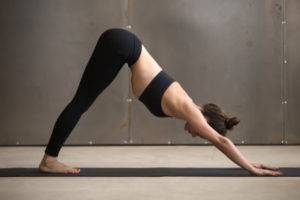 |
Crescent Pose – strengthens abs, hip flexors and chest. Feet one in front of the other, bend the front leg to 90 degrees, while keeping the back leg straight and flexing the hips forward. Raise your arms above your head, beside your ears with the palms facing inwards. |
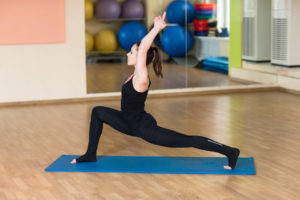 |
Leg Stretch – for your hamstrings and core muscles. Lie on the floor with your legs in the air. Lower one leg, pulling the other towards your chest. If you can, raise your shoulders from the floor. |
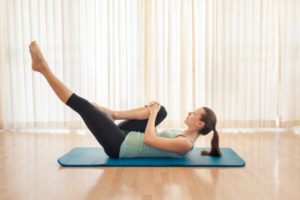 |
Side Oblique Stretch – for your lats, hips and obliques. Stand with feet wider than shoulder width apart. Bend to the side whilst you slide one hand down your leg and raise the opposite one above your head, return to upright and repeat on the other side. |
 |
The Cat – stretches all your back muscles. On your hands and knees, curl your back up, pulling your stomach toward your spine. Follow this one with: |
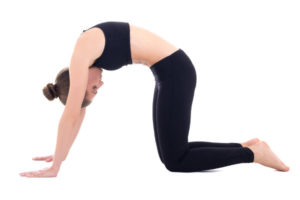 |
The Cow – this works your abs and chest. Essentially, reverse the cat. So instead of your back curving up, it arches, head and chest up and spine curved towards the stomach. |
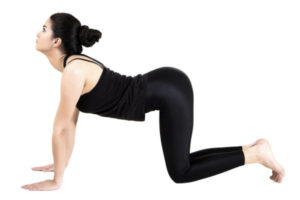 |
Side Lunge – this stretch helps with the inner thighs. Start with feet wider than hip distance apart. Slide one foot out to the side, leg straight, while bending the other leg, pushing the butt back and leaning forward slightly. Touch the floor with your fingers if you can. |
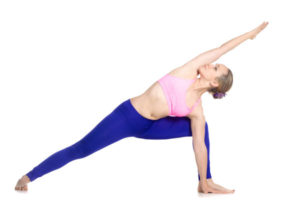 |
Childs Pose – this one is great for calming and stress relief as well as lower back, lats and shoulders. From the position of hands and knees, hip width apart, push back until your butt is on your heels and your arms are stretched out in front of you, your chest pressed to your thighs. Keep your head down between your arms. |
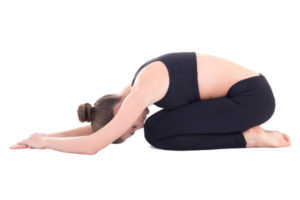 |
How to stay fit while Travelling
Summer is almost upon us, and that means summer holidays!
Australian’s love to travel. And they love to keep fit. But how can you do both? Lots of hotels have gyms these days, but let’s face it sometimes they are less than impressive. Not to mention they are often full of people who don’t normally train. Serious gym lovers can find this frustrating. Coming from Australia, you are often in another time zone, so your body clock and routine is out of whack, and you may feel like exercising at odd times in the day – especially if you are having trouble adjusting. So, how do you get a workout in without spending hours in the hotel gym? Here are some tips on getting a quick, efficient workout done without leaving your room!Warmup
As you know, it is really important to warm up before exercising. Particularly if you are feeling a little stiff from a long-haul flight or unfamiliar bed. Five minutes is usually enough, so try 30-60 seconds of each of the following:- Toe Touches
- Jumping Jacks
- Shoulder Circles
- High Knees
- Core Twists
- Leg Swings
Exercises
What you need is a combination of exercises that will work your core, glutes, lower back, hamstrings, quads, biceps, triceps, upper back, and chest. If time is of the essence, set your phone alarm and do as many sets of the following as you can in the time allowed. Ideally, you should aim for two or three sets of 10-15 repetitions for each exercise, depending on your fitness level and goals.- Pushups – ideally on your toes, but on your knees is ok if you must
- Tricep Dips – use a chair or the bed –whichever offers you the best height
- Squats – keep a chair behind you if it gives you confidence or security
- Leg Lifts
- Plank & Side Plank
- Standing Bicycle Crunch
- Single Leg Stand – use a chair, the bed will probably be too soft
- Heel Raises
Cool Down
As you know, cooling down is very important in any exercise routine – even if it is in a hotel room! In this case, it will be all about stretching – touching your toes; stretching your arms across your body; sliding your hands down your sides and if appropriate, go for a walk up and down the hotel corridor. If you follow these simple exercise tips daily you should be able to keep yourself in shape, and maybe even allow yourself the odd treat (cocktails have calories too!) on your well-earned Christmas holiday. If you would like more information about how to do these exercises, or what exercises are appropriate to you call our Baulkham Hills clinic on (02) 9639 7337.Thyroid Dysfunction
It’s all about the balance
The Thyroid is a butterfly-shaped gland at the base of our throat and is part of the endocrine system. Just about every organ in the body is affected if the thyroid is not functioning optimally. For a tiny little gland, it can have a huge impact. Heart and digestive function, metabolic rate, muscle control, brain development, and bone maintenance are all impacted by your thyroid. Thyroid dysfunction occurs more often in women than men and is more common in people who suffer from other autoimmune diseases, such as Coeliacs. It generally happens during the 40s. Since the thyroid requires a good supply of Iodine to function, those with low-iodine diets are also at risk.So, if you are having trouble with your thyroid – what can you do?
Firstly, the thyroid can malfunction in two main ways – overactive, or Hyperthyroidism; and underactive, Hypothyroidism. If your thyroid is overactive you are likely to suffer from- rapid and irregular heartbeat
- palpitations
- increased appetite
- tiredness
- irritability
- reduced appetite, but suffer weight gain
- develop an intolerance of the cold
- have a low heart rate
- poor memory
- stiff muscles
- a chance to suffer infertility.
Traditional Chinese Medicine is all about maintaining the balance of yin and yang in the body, so it makes sense that this type of treatment can help with thyroid dysfunction, which is essentially an imbalance of hormones. Interestingly, thyroid imbalances were noted in Chinese texts around 300BC. Generally, a practitioner will establish which organs of the body have been most affected by the thyroid dysfunction, in order to determine the correct course of treatment. This is likely to include a combination of Acupuncture, Herbal Medicine and dietary changes, which will be used to restore the Yin/Yang balance. There are eight acupuncture channels connected to the thyroid gland, and these can be used to determine which aspect of the body is most affected by thyroid dysfunction, and address the symptoms. Moxibustion and cupping may also be used in treatment depending on the specific diagnosis.
At Precision Health Spine & Sports Clinic our highly regarded Traditional Chinese Medicine specialist is available Monday, Tuesday, and Friday 2 pm till 7 pm. Book an appointment online now, or call our clinic. If you have any form of thyroid dysfunction and would like to seek advice or treatment, call our Baulkham Hills Clinic on (02) 9639 7337.
Why we shrink as we get older
There’s no getting away from it. As we age, we shrink. All of us. There are a number of reasons for this, however possibly the most debilitating and painful is spinal stenosis.
The spine gets a lot of wear and tear over our lifetime. As we age, this wear and tear can cause degenerative changes. Sometimes these degenerative changes are accelerated by trauma – either at work or in a sport. Unfortunately, this degeneration can cause a great deal of pain. Each vertebra of the spine is separated by an intervertebral disc, that acts as a cushion to absorb shock and helps us bend. As we age, these discs begin to dry out and flatten, which reduces the space between the vertebrae. And so we shrink. But that isn’t the only problem. This thinning of the discs can cause bone on bone friction. The body responds to this friction by adding bone to the area, causing bony growths on the vertebrae. This is a problem if the growths impinge on the spinal canal or the nerve root canal as it narrows the canals and can cause a great deal of pain. This is called ‘stenosis’.Symptoms
Depending on which parts of the spinal column are affected, patients will feel pain in their arms and hands or their legs. Pain is generally described as like toothache pain or lightening. If the stenosis is in the upper (cervical) spine patients might feel pain like an electric shock down their spine and into their arms and hands. Pain increases with movement and reduces with rest. In extreme cases, stenosis can cause lack of control of bladder or bowels and even paraplegia or quadriplegia.Treatment
Diagnosis is generally made via X-ray, MRI or CT Scans. Once diagnosed there are a number of treatment options for stenosis, although there is not a cure. Treatment rather focuses on the symptoms and pain reduction. The key is to keep the area mobile and to increase stability around the spine, strengthening adjacent muscles. Chiropractic spinal mobilization will help take pressure off the spine relieving pain and discomfort. Ultrasound and acupuncture may be used and exercises prescribed. Anti-inflammatories can assist with reducing irritation. Massage will help relieve associated muscle pain, and again keep the area mobile. In extreme cases, steroid spinal injections and even surgery may be required. A laminectomy will shave off some of the bone growths to relieve pressure on the nerves. This will sometimes be followed by spinal fusion surgery to create more stability.If you think you may be suffering from spinal stenosis, call Precision Health Spine & Sports Clinic on (02) 9639 7337 to make an appointment at our Baulkham Hills clinic.


